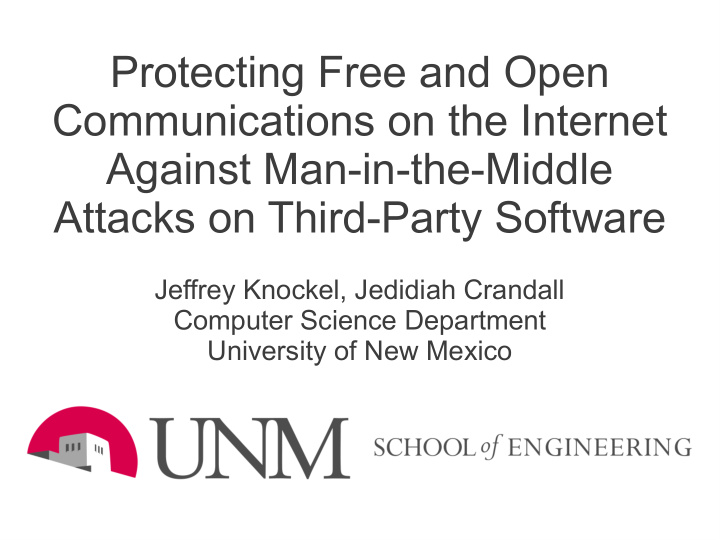



Protecting Free and Open Communications on the Internet Against Man-in-the-Middle Attacks on Third-Party Software Jeffrey Knockel, Jedidiah Crandall Computer Science Department University of New Mexico
Recent News ● Iran: forged SSL certificates for update servers[1] ● Egypt: government licensed FinFisher to exploit iTunes updates[2] ● Flame malware exploits MD5 collision with Windows updates[3] [1]https://blog.torproject.org/blog/diginotar-damage-disclosure [2]http://www.theregister.co.uk/2011/09/21/egypt_cyber_spy_controversy/ [3]http://krebsonsecurity.com/2012/06/flame-malware-prompts-microsoft-patch/
Insecure HTTP
Unsigned Executables
Software Updates ● Performance ● Security ● Under one minute install
Problem ● Untrusted networks ● Hotel/coffee shop wireless ● Foreign country ● A man in the middle can exploit even sophisticated updaters using asymmetric crypto
Sun Java
Exploit Time Frame ...September 2011 — February 2012
Updates ● We look at Java 6 (Java 7 is analogous) ● Automatic updater periodically queries javadl-esd.sun.com/update/1.6.0/map-m-1.6.0.xml ● Points to update information javadl-esd.sun.com/update/1.6.0/au-descriptor-1.6.0_31-b79.xml ● Contains ● URL for installer ● Command line arguments ● SHA1 hash of installer
Verification ● Installer is downloaded and verified ● Against XML-provided hash ● To have “Sun Microsystems, Inc.” digital signature ● To have a PE version number at least as high
To Exploit ● We want an executable that ● Has same SHA1 hash as in XML – We can provide a different hash ● Has a “Sun Microsystems, Inc.” digital signature ● Has a PE version number at least as high ● Can still somehow run arbitrary code
Exploit ● javaws.exe
Exploit ● javaws.exe ● Arguments: ● http://url/to/hello.jnlp ● -J-Djava.security.policy=http://url/to/grantall.jp ● -Xnosplash grant { ● -open permission java.security.AllPermission; }; ● Fixed in Java 6 Update 31, 7 Update 3 ● HTTPS to fetch XML
Impulse SafeConnect
Exploit Time Frame ...July 2011 — August 2011
Updates ● Silently updates itself ● Connects to hard-coded 198.31.193.211 via HTTP (only accessible on campus) ● XML communication encrypted via Blowfish key in ECB mode (reverse engineered): \x4f\xbd\x06\x00\x00\xca\x9c\x18\x03\xfc\x91\x3f
Verification ● Server responds with Blowfish-encrypted URL's and MD5 hashes for updated files ● Files are downloaded ● Files are verified to have “Impulse Point LLC” digital signature
Problem ● Blowfish encryption is symmetric ● We can receive XML updates ⇒ We can send client arbitrary XML ● ● But update files need signature
Exploit ● Get around digital signature verification ● “Upgrade” to an older client that is signed but performs no check ● “Upgrade” older client to arbitrary code ● Fixed by 5059.242 by using HTTPS ● Must be on campus to receive fix ● HTTPS private key one hop away
Other Programs ● Virtualbox (verification left to user) ● Downloads update information via HTTP ● Download links open in browser
Other Programs ● Adobe Flash (suspicious) ● Downloads XML via HTTP ● Verifies digital signature of installer ● Downloaded installer verifies that a newer version of Flash is not installed ● Google Chrome (cool) ● Downloads signed XML via HTTP ● Verifies XML's signature ● Downloads installer via HTTP ● Verifies installer's hash against XML
Impact ● These aren't hard to find ● With just two, we could own ● Windows + Java users ● Anyone on our campus wifi ● Governments can do much better than us
Solutions? ● Smart people really have difficulty doing updates ● Despite trying really hard ● How can we protect the FOCI of users on untrusted networks?
Solutions? ● Find and fix vulnerable software? ● All vulnerable software ● Most vulnerable software ● Give users tools to detect unsafe updates? ● Blacklist ● Dynamic analysis
Solutions? ● More libraries? OS-provided service? ● Optional (TUF[4]) ● Required... ● Walled gardens? ● Walled gardens commonly censor[5] – Competing technology – Obscene material – Religiously controversial material – Content “over the line” [4]https://theupdateframework.com/ [5]https://developer.apple.com/appstore/resources/approval/guidelines.html
Acknowledgments This material is based upon work supported by the National Science Foundation under Grant Nos. #0844880, #0905177, and #1017602. Any opinions, findings, and conclusions or recommendations expressed in this material are those of the author(s) and do not necessarily reflect the views of the National Science Foundation.
Recommend
More recommend